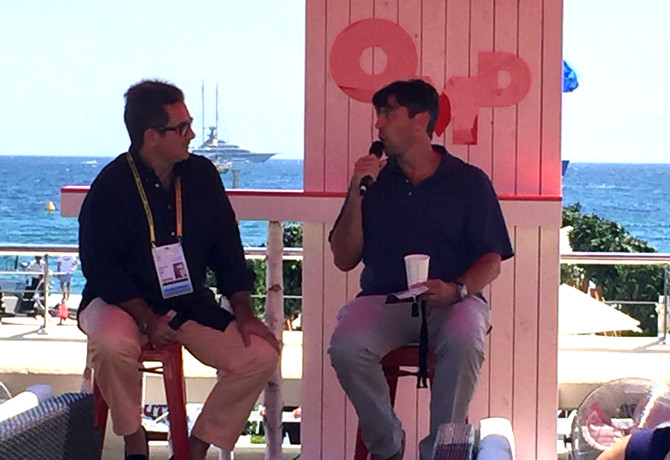Chrissie Hanson, global communications planning leader at OMD, reflects on the launch strategy for Verizon’s newly merged AOL-Yahoo business, ‘Oath’.

It’s not often that a global CEO opens up about the challenges that his organisation is facing and turns the interview around to ask advice from the interviewer. But Cannes invites disruption, and open-source is a theme that’s been running through a number of panels this year, this session included.
So it was with much anticipation that we took our seats in the OMD Oasis to listen to the riveting fireside chat between Tim Armstrong, CEO of Oath (Verizon’s AOL and Yahoo merger) and Mainardo de Nardis, CEO of OMD Worldwide.
It was a rapid and brilliant exchange that ran the gamut of Oath’s purpose and goals, its short and medium-term challenges, predictions around the future of content (both brand-centric and performance-led), and the need to broaden our understanding and definition of data transparency. Armstrong laid out the elements for organisational change and three lessons emerged.
1 – Emotional involvement and personal belief are key
The name of the company itself is steeped in emotion and solemnity and this was intentional. As Armstrong explained, ‘Oath’ ignited both internal and external discussion and prompted employees to define their own three-word promise. This immediately involved and engaged people – a critical step in ensuring that your employees believe in the company’s new vision and mission. And for those of you wondering what Tim’s oath is, well it’s, “Never give up,” of course.
2 – Speed of execution demands clarity of upfront strategy
Armstrong had 14 minutes to announce the launch of the merger before the press did back in April, and he did it via a single tweet that earned $100m of media coverage. That’s undoubtedly a record time for any company announcement, let alone the unveiling of one of the most talked about mergers of the year, but that level of speed was only possible because of the extensive work that had been done in the many months running up to that moment. Preparation powers agility and readiness.
3 – Openness is a behaviour and a process to be cultivated
Armstrong exemplified this behaviour when he asked de Nardis for advice on how to solve a challenge that has arisen from the merger which is this: “How do you choose between two equally qualified people?”
De Nardis’s response was two-fold: you must create a culture that focuses on the future and keep people from harping back to how things were done before, and you must ensure that the change you seek starts at the top.
The conversation then shifted to the future of content and Armstrong explained that the marriage of data and stories demands attention, because “programmatic muscles are big, but storytelling muscles have atrophied”. De Nardis agreed, stating that as our sources of content have expanded exponentially, there is an urgent need to synchronise, sequence, and orchestrate it for the benefit of brands.
Armstrong’s route to achieving this contains both sensible as well as more provocative and friction-sparking steps for the industry:
Hook on to Universal Consumer Behaviours but Execute the Strategy Locally
People want both the two-minute snackable snippets of content but also the more involving, richer, long-form content. And with a potential 8,760 minutes available in the year, Armstrong wants his fair share of your time. But this will only be achieved through laser sharp consumer insight that is tailored to the needs of audiences in each market, hence the need to harness both shared consumer motivation with locally relevant insights.
Move towards delivering enjoyable two-way experiences with ads to avoid ad blocking
Not only will Oath involve more storytellers in their content (they’re aiming to have 10 million storytellers and creators by 2020), but the commitment to put consumers first means that Oath will push back on advertisers who deliver poor experiences. In the not-so distant future, we can expect Oath to tell brands that they cannot run a single creative more than 50 million times but that they need to expand their creative assets in order to deliver more involving, enjoyable, and effective experiences.
Pay Consumers for their Data
This was a controversial point but one that’s likely be welcome by consumers and it’s that the business models of the future will be the ones that reward consumers for the data that they share. Our understanding of data transparency will shift beyond simply the financial transaction and include how and where that data is used, as well as the benefits that can be harnessed by the consumer.
Armstrong concluded by saying that Oath wants to be an “awesome partner” to both brands and agencies and that he doesn’t believe in the term “frenemy”. Sharing and operating in an open-source manner is critical for business, and it’s clear that we can expect much more innovation and disruption to come from Oath in the months and years ahead.







